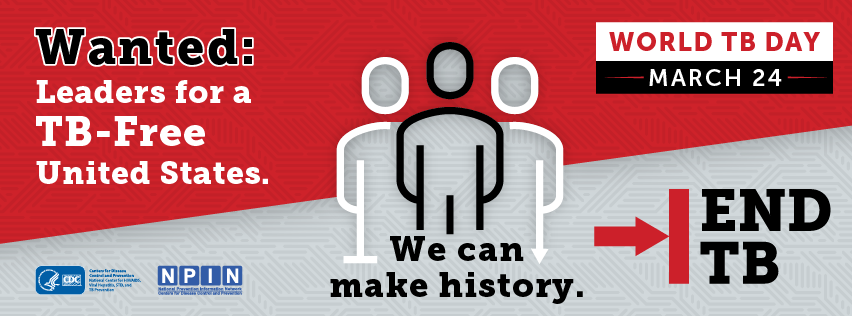Tuberculosis (TB) persists as a problem in the United States with 9,272 cases detected in 2016, according to CDC. To maintain awareness of this continued threat and honor Dr. Robert Koch’s discovery of the bacteria that causes TB, March 24 is recognized as World TB Day. This year’s theme, “Wanted: Leaders for a TB-Free World. You can make history. End TB,” encourages us to strive for TB elimination and begs the question: Who’s leading the charge?
For over 100 years, local public health has served in a vital leadership role regarding TB prevention and control. Contact investigation, outbreak response, and linkage to care are just a few examples of the responsibilities assumed by local health departments (LHDs) to protect communities against TB. These expectations are often uniform across the country, despite a wide variability in capacity, staff, and funding.
Local Efforts to End TB: Bridging Healthcare and Public Health
TB contact investigations involve identifying individuals who have been exposed to someone with TB disease and providing or linking those individuals to appropriate care to prevent further spread or an outbreak from occurring. The timeline for completing a case investigation can range from a few months to more than a year depending on factors such as length of treatment regimen, rate treatment follow-through, and the number of case contacts. Less obvious, perhaps, are cultural challenges that may impact an investigation. For example, certain individuals may be hesitant to engage with governmental public health due to language barriers or fear around citizenship status. When compounded, these challenges can make one investigation very complicated and lengthy. Complex and time-consuming investigations place a particularly heavy burden upon cities and counties with low incidence, as these locales are less likely to have full-time staff dedicated solely to TB investigation. When a case of TB does occur in these areas the subsequent investigation can divert a staff member from his or her usual responsibilities for months at a time. As cases are identified throughout the investigation, LHDs are then required to provide or connect patients with care. This can be especially difficult when local access to specialty care for TB is limited and patients may be required to travel in order to receive care.
Responding to active cases and conducting contact investigations often takes priority, particularly in an increasingly stringent fiscal environment. And while investigation and response are important in minimizing the spread of TB in communities, proactive prevention efforts must be bolstered in order to approach the goal of ending TB. The CDC estimates that up to 13 million people in the US have Latent TB Infection (LTBI) and while they are not currently sick with TB disease, they are at risk of developing it. Diagnosing and treating individuals with LTBI is fundamental to TB prevention. To maximize limited resources, these prevention efforts should be targeted towards high-risk individuals – which include people experiencing homelessness, people who inject drugs, and people living with HIV.
Two notable common threads exist among these various challenges. The first is that local health departments have pursued innovative solutions to overcome them. Some smaller or rural health departments, for example, have partnered with neighboring counties through shared service grants or other agreements to maximize regional staff capacity and improve local ability to manage caseloads. The second commonality is that increased provider engagement could improve the reach and sustainability of solutions. The public health and healthcare connection has been leveraged for other public health threats, such as emerging infectious diseases and healthcare-associated infections, but there may still be a need to further bridge the gap when it comes to TB. Healthcare providers are well-positioned to manage treatment for cases of low complexity, which would allow public health nurses to focus on more involved investigations and case follow-ups. More robust provider involvement could also improve prevention efforts by increasing capacity to test high risk populations for LTBI. In 2016, the U.S. Preventive Services Task Force developed a recommendation to expand LTBI testing among high-risk individuals. This recommendation provides the foundation for healthcare providers to scale up prevention efforts.
Looking Ahead
In the search for leaders in TB elimination, local health departments emerge as unsung heroes: investigating, assessing, and linking to care those individuals who have been exposed and protecting communities from further spread. Despite tight budgets and other challenges, LHDs across the U.S. push beyond the bare minimum to increase proactive prevention activities. In 2017, the CDC recognized thirteen individuals and organizations contributing to TB elimination. These TB Elimination Champions included the Fulton County Department of Health and Wellness (GA), Allentown Health Bureau (PA), and Los Angeles County Department of Public Health (CA), whose activities included expanding free TB screening and treatment options for LTBI across the community, ensuring that homeless shelter clients receive annual TB testing and screening, and implementing a TB clearance card program among homeless shelters. So, while increasing the sense of shared responsibility may catalyze current efforts, these examples reinforce that LHDs continue to serve as tireless leaders in the effort to “End TB” in their communities.
To learn more about World TB Day and how you can get involved, visit the Stop TB Partnership. If you are looking to educate and engage your local providers in TB activities, check out these CDC materials tailored to providers.



